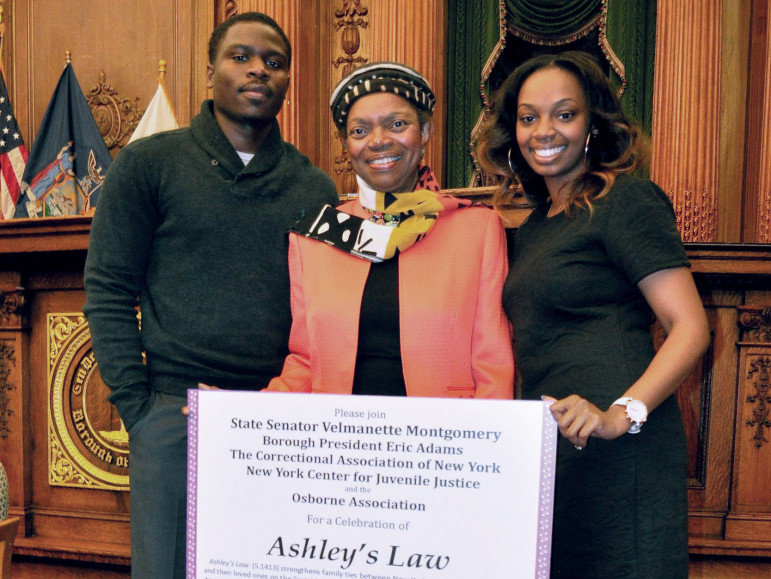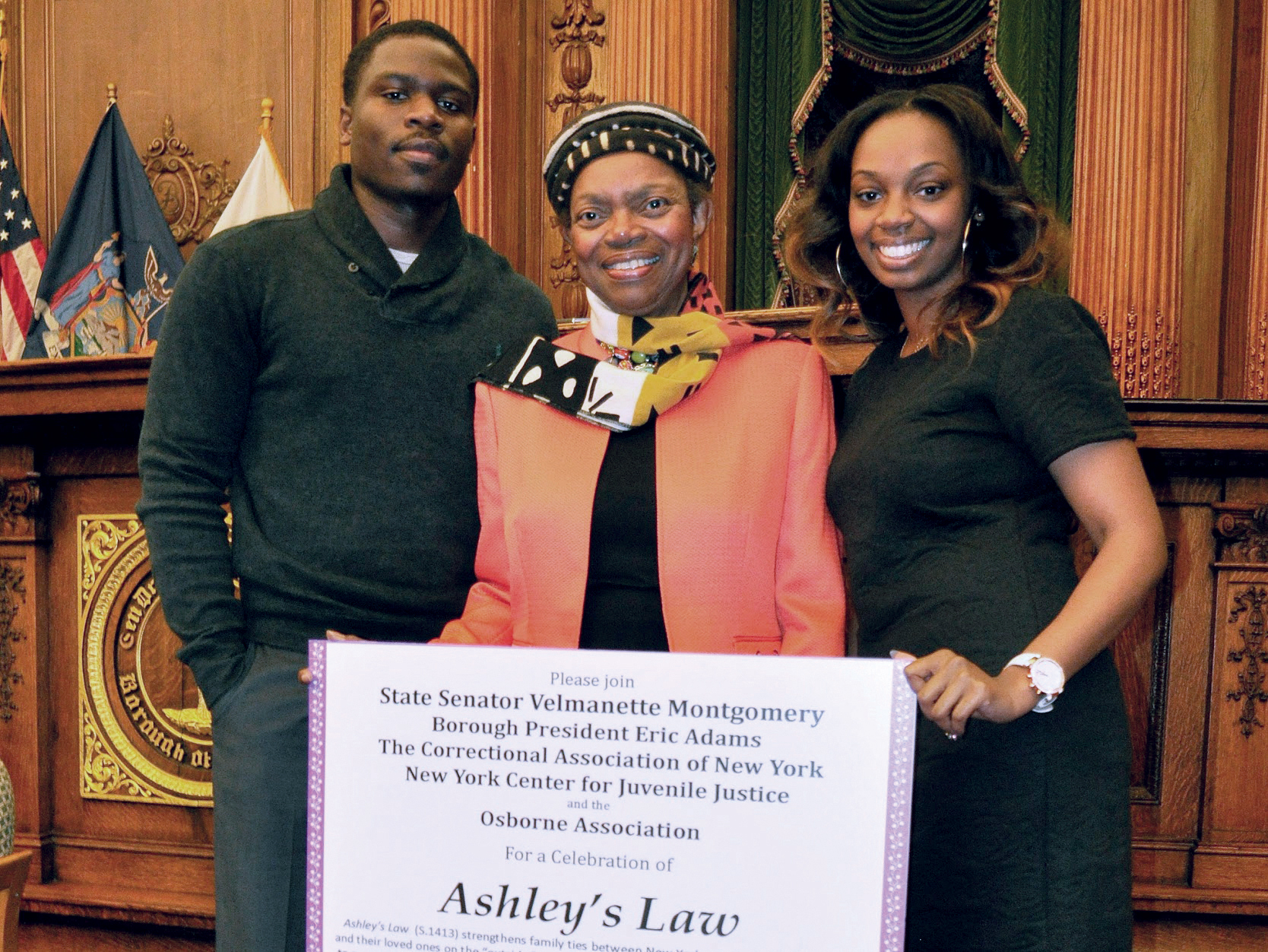
Courtesy of NYS Senator Velmanette Montgomery, Photo by J. Vogel
From left to right: Jim St. Germain, a youth advocate representing Raise the Age Coalition, New York state Sen. Velmanette Montgomery and Ashley Duncan.
New York — Ashley Duncan awoke at 5 a.m. to visit her father who was incarcerated at Sing Sing in upstate New York. After two hours on a train, accompanied by her grandmother, Ashley arrived at the prison, where correction officers demanded that she remove her underwire bra in a bathroom and pass through a metal detector. Duncan hurried through and into another bathroom to put her bra back on. Forced to use two different bathrooms and made to feel like a criminal, Duncan said, the indignity of her father’s wrongdoings followed her throughout childhood.

This story was produced by The New York Metro Bureau, a collaboration between the Center for Sustainable Journalism (the publisher of Youth Today and its sister publication The JJIE.org) and the City University of New York’s Graduate School of Journalism. It is made possible by the generous support of the Tow Foundation.
Duncan’s father was incarcerated for a string of armed robberies when she was 4 years old. She recalls seeing families turned away from visitation because they wore the wrong clothing or brought the wrong ID. Duncan said she was confronted by any number of “so-called” rules about shirts cut too high or too low, a visible back, ripped jeans. During numerous visits she sat, sifting through a pile of used T-shirts, inconvenienced and exhausted after hours of travel because the prison visitation rules were unclear.
The U.S. has the highest incarceration rate and the largest prison population of any country in the world. On any given day, an estimated 2.7 million minor children (under age 18) have an incarcerated parent, according to the Pew Charitable Trust 2010 report “Collateral Costs.”
Tanya Krupat, a program director at the Osborne Association, a nonprofit criminal-justice organization based in New York City, said young people’s experiences with law enforcement or the prison system are rarely considered during parental arrest or incarceration.
Duncan, now a 21-year-old elementary education major at Virginia Union University, didn’t aspire to create legislation. But Ashley’s Law, a family visitation law requiring the New York State Department of Corrections and Community Supervision to make known to the public specific visiting rules at more than 50 state prisons in New York, was signed into law by Gov. Andrew Cuomo last August.
Young people inspire reform
Duncan said there was a time when inconsistent rules discouraged her from visiting her father, and she hopes barriers to visitation don’t have other children of an incarcerated family member drawing the same conclusions.
“I’m so excited,” said Duncan. “I hope this will make it easier for families to visit their incarcerated loved ones.”
Brooklyn Borough President Eric Adams praised Duncan’s fearlessness and initiative.
“When you travel eight or nine hours upstate to visit someone, sometimes it feels like you’re doing time. Ashley turned her pain into purpose,” he said.
In 2010, Duncan joined the Youth Advisory Board at The Osborne Association and began sharing her experiences within the justice system, experiences which later inspired Ashley’s Law. Krupat said Osborne hopes to involve youth in the legislative process and to use their experiences, anger, pain and courage to initiate reform.
Osborne uses a model inspired by Project WHAT! in the San Francisco Bay Area. Project WHAT is a youth-led program where teens ages 14 through 19 are the primary content developers and decision makers. Using a peer-to-peer model, young people train their peers to lead presentations and workshops about parental incarceration, testify on different issues and work on local policy legislation. Recently, Project WHAT! worked with the San Francisco Children of Incarcerated Parents on a policy to minimize child trauma during arrest procedures. On May 7, San Francisco Police Chief Greg Suhr adopted DGO 7.04, requiring officers to consider the wellbeing of children during parental arrests. Project WHAT! youth are now featured in a police training video that they helped create based on their experiences.
Youth-led advocacy training
Other organizations across the country have also realized the power of letting young people tell their own stories and use a similar model. One such organization is California Youth Connection (CYC), started in 1988, and now operating in 33 chapters statewide.
CYC teaches leadership and advocacy skills to young people in order to engage directly with policymakers to improve the foster-care system. Lauren Parker, communications and development associate at California Youth Connection, said it is easy to think of foster youth as an out-of-sight, intangible unit, but hearing young people tell their stories and ask for a better outcome for others is difficult to ignore.
CYC hosts a summer leadership conference to pinpoint which changes are most important to foster youth, offers training in advocacy and hosts a Day at the Capitol conference every year. In February, 146 young people (and 56 adult supporters) from California attended to speak to legislators and press about their platform. Recently, CYC successfully passed legislation, sponsored by Sen. Darrell Steinberg, to improve the facilitation of visitation for foster youth.
“There is nothing more powerful than young people speaking for themselves,” said Krupat, who credits New York Sen. Velmanette Montgomery (D-Brooklyn) for taking Duncan’s story and creating the legislation.
“Young people, when they can, have a lot to say, but not everyone who has the power to listen and run with it does so,” said Krupat.
Not just in memorandum
Montgomery agreed the legislature lacks youthful voices. Memorial laws have existed for decades, one such law being the 1994 Megan’s Law, requiring law-enforcement authorities to make information available to the public regarding registered sex offenders. Such personalized laws often call attention to specific acts or victims within a community.
But these laws are often created by adults to memorialize victims. Young people are often the impetus for legislative change, but that change comes too late to help them.
Still, Montgomery hopes to get young people excited about and involved in the legislative process. She encourages young people to share their stories firsthand so policy makers can learn from their experiences. She also advises them to get involved in internships in legislature, nonprofit or advocacy groups. Once students become familiar with the process and see it work, they will see that it is a viable means to address issues that are important to them, she said.
“We can’t just talk about them,” she said. “We have to talk to them and follow them.”
Parker also encourages other organizations to engage youth even if they are not advocacy organizations. Organizations can contribute by listening to young people’s stories, sharing reading material, volunteering, throwing fundraisers or giving donations.
When Ashley joined Osborne’s Youth Advisory Board (YAB), she was a teenager who wasn’t seeking any sort of law or recognition. The YAB was a safe space for her to tell her story without judgment or bias. It was the first place where she could learn to talk about the justice system and how she wished her experiences had been different. The confidence gained here paid off when she went to Albany and delivered the moving story that inspired Montgomery to sponsor Ashley’s bill. Montgomery is also currently sponsoring two other bills inspired by young people, Raymond’s and April’s bills, and hopes that even more young people will be inspired to come forward and tell their stories.


























